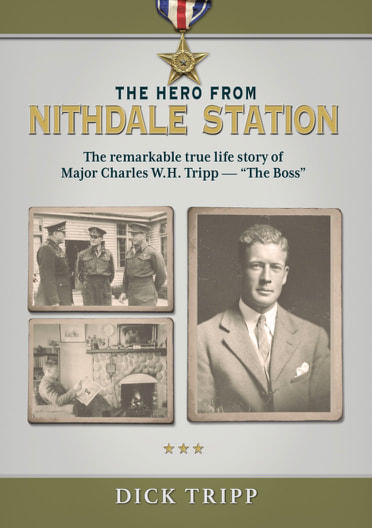
by Dick Tripp
It was entirely appropriate that this book came to me around Anzac Day, for much of the ambience around a commemoration that the Foreword claims ‘… threatens to evaporate away as the memory of its characters fades …’ is present in this book. The dwindling numbers of veterans left to us is one such threat, but the burgeoning numbers of young people turning out for commemoration services in Oceania, Great Britain and Turkey is a counterbalancing guarantee that ‘We will remember them.’
This can only be underlined by the life stories of such legendary figures as Major Charles WH Tripp, a man who might have sprung, fully-formed, from the pages of ‘The Boys’ Own Paper’. Eccentric beyond doubt in the matter of his outstanding dedication to physical fitness, Tripp was the sort of person on whom empires were and are founded. It emerges as no surprise that his favourite poet was Kipling, the ‘poet of Empire’ and Tripp can readily be imagined on the Northwest Frontier; as a tea-planter in Assam or as a ‘Mountie’ in the Canadian wilderness. That Fate made him a member of the South Island squirearchy was the good fortune of New Zealand, the United States and Great Britain, all of which honoured him for his Pacific War service with the Fiji Guerrillas.
This formation, as with the British Fourteenth Army in Burma, has been little-appreciated in the pantheon of World War Two stories, but its contribution to the Pacific War in terms of scouting, reconnaissance, guiding and information-gathering was both immense and recognised as such by those American generals who led armies of farmhands and city-boys to war there.
Charles Tripp took a leading part in the activities of this unit, whether training or combat, and led it from the front in a totally ‘follow-me’ manner that redefined the very concept of leadership. Some way older than the men he led, he was also fitter, stronger and tougher, mentally as well as physically. Always up-front and in the thick of things, his immense nerve and courage lent him a charmed life which was never better exemplified than when he took a bullet from a Japanese rifle in the chest at short range only to be saved by the contents of his pocket, which included a notebook and cigarette-lighter that cushioned the impact to the point where the major injury done was only to his uniform. How much stranger than fiction is truth?
His variety of experiences included walking around and through Japanese encampments by night cutting telephone wires: navigating patrols through jungle so dense that the Japanese eschewed it; leading men in the ferocity of hand-to-hand combat and, unbelievably, successfully charging a Japanese bunker while mounted on a bulldozer with the blade down to deflect bullets. ‘Boys’ Own’ stuff indeed, but these and similar exploits while deployed in contact with the enemy on an almost daily basis earned him the veneration of New Zealanders, Americans and Fijians alike and the number and quality of his decorations bear witness to that.
His post-war activities reveal the same emphasis upon community, empathy, care for others and leadership that had marked his contribution to the armed forces and which stamp Tripp as one born to lead. That same ethos of service above self is echoed in the award of a Queen’s Service Medal to Tripp’s wife, Myra, for the sort of community service that was the breath and staff of life for this outstanding family.
Unfortunately, the structure of this compelling book is less remarkable than the life stories of its subject. While any lack of balance is excused by the author’s decision to write a work of hagiography, certain things remain requirements nonetheless.
In the first place, the decision to structure the book as a collection of anecdotes rather than a biography has had a profound effect upon its readability. Paramount here is an absence of detail; for example Tripp’s date of birth becomes apparent only in his obituary; we are not told when he began at Cambridge University despite his rowing prowess being a highlight; the earliest links between the Pinckney and Tripp families are shrouded in mystery, and, perhaps most central to the story of an outstanding young man with little work history making his way in the world on the eve of the Depression, readers are left to wonder how he manages to finance the purchase of a 3500 acre farm, stock it handsomely and employ workers.
Secondly, some of the book’s content as ‘what everyone knows’ stamps it as being for local, rather than national, consumption. Prominent in this is the absence of a map showing the location of places featuring repeatedly in the story, notably Orari Gorge, and Glenaray Station, and this reviewer was forced to resort to the ‘AA Road Atlas’ and even then with only limited success in the mystery of Glenaray Station.
None of this is covered in a work of anecdote, and any ‘Life and Times of …’ type of memoir surely requires them.
Third, the work suffers from failings in proof-reading. ‘Earnest Shackelton’; ‘Galashielsds’ and ‘Dumfriedshire’ are all only a Google-search away, and there is thus little excuse for these infelicities.
However, the story of Major Charles WH Tripp, lovingly and enticingly told by his son, goes beyond fascinating and into the riveting. If ever there was a need to accord a great New Zealander a full and proper biography, it is here.
Author: Dick Tripp
Publisher: Wild Side Publishing
ISBN: 9780473462291
RRP: $24.99
Available: bookshops

 RSS Feed
RSS Feed
